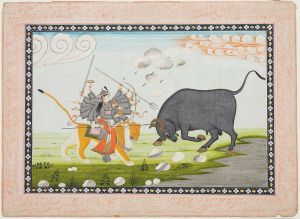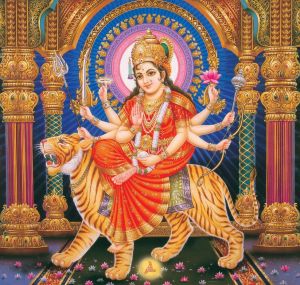Durga (Sanskrit: दुर्गा, IAST: Durgā) is a major Hindu goddess
Durga (Sanskrit: दुर्गा, IAST: Durgā) is a major Hindu goddess, worshipped as a principal aspect of the mother goddess Mahadevi. She is associated with protection, strength, motherhood, destruction, and wars.
Durga's legend centers around combating evils and demonic forces that threaten peace, prosperity, and dharma, representing the power of good over evil. Durga is believed to unleash her divine wrath against the wicked for the liberation of the oppressed and entails destruction to empower creation. Durga is seen as a motherly figure and
often depicted as a beautiful woman, riding a lion or tiger, with many arms each carrying a weapon and often defeating demons. She is widely worshipped by the followers of the goddess-centric sect, Shaktism, and has importance in other denominations like Shaivism and Vaishnavism.
The most important texts of Shaktism, Devi Mahatmya and Devi Bhagavata Purana, revere Devi (the Goddess) as the primordial creator of the universe and the Brahman (ultimate truth and reality). She is one of the five
equivalent deities in Panchayatana puja of the Smarta tradition of Hinduism. She is also considered as the younger sister of Vishnu as per Bhagavata Purana.
Durga has a significant following all over India, Bangladesh, Nepal, and many other countries. She is mostly worshipped after spring and autumn harvests, especially during the festivals of Durga Puja, Durga Ashtami, Vijayadashami, Deepavali, and Navaratri.
Etymology and nomenclature
Part of a series on
Shaktism
History Deities Scriptures and texts Schools Scholars Practices Festivals and temples Regional Variations
Hinduism portal
vte
The word Durga (दुर्गा) literally means "impassable", "invincible, unassailable". It is related to the word Durg (दुर्ग) which means "fortress, something difficult to defeat or pass". According to Monier Monier-Williams, Durga is derived from the roots dur (difficult) and gam (pass, go through).[24] According to Alain Daniélou, Durga means "beyond defeat". ]
The word Durga and related terms appear in the Vedic literature, such as in the Rigveda hymns 4.28, 5.34, 8.27, 8.47, 8.93, and 10.127, and in sections 10.1 and 12.4 of the Atharvaveda. [note 1] A deity named Durge appears in section 10.1.7 of the Taittiriya Aranyaka.[24] While the Vedic literature uses the word Durga, the description therein lacks the legendary details about her that are found in later Hindu literature.
The word is also found in ancient post-Vedic Sanskrit texts such as in section 2.451 of the Mahabharata and section 4.27.16 of the Ramayana.[24] These usages are in different contexts. For example, Durg is the name of an Asura who had become invincible to gods, and Durga is the goddess who intervenes and slays him. Durga and its derivatives are found in sections 4.1.99 and 6.3.63 of the Ashtadhyayi by Pāṇini, the ancient Sanskrit grammarian, and in the commentary of Nirukta by Yaska.
Epithets
Durga is commonly known as Mahisa-mardini for slaying the half-buffalo demon Mahishasura. She is also known as Vindhyavasini (she who dwells in the Vindhya Mountains). Her other epithets include Mahamoha (great delusion), Mahasuri (the great demoness), and Tamasi (the great night, the night of delusion).
There are many epithets for Durga in Shaktism and her nine appellations are (Navadurga): Shailaputri, Brahmacharini, Chandraghanta, Kushmanda, Skandamata, Katyayini, Kalaratri, Mahagauri and Siddhidatri. A list of 108 names of the goddess is recited in order to worship her and is popularly known as the "Ashtottarshat Namavali of Goddess Durga".[citation needed]
Other meanings may include: "the one who cannot be accessed easily" "the undefeatable goddess".
Durga is also known as Durgati Nashini, meaning one who eliminates suffering.
Her other names include Chandika, Sharada, Ambika, Vaishnavi etc.
History and texts
Evidence of Durga-like images can probably be traced back to the Indus Valley civilization. According to Asko Parpola, a cylindrical seal from Kalibangan shows "a Durgā-like goddess of war, who is associated with the tiger".
Reverence for Devi, the feminine nature of God, first appears in the 10th Maṇḍala of Rig Veda, one of the scriptures of Hinduism. This hymn is also called the Devi Suktam hymn (abridged):
I am the Queen, the gatherer-up of treasures, most thoughtful, first of those who merit worship.
Thus gods have established me in many places with many homes to enter and abide in.
Through me alone all eat the food that feeds them, – each man who sees, breathes, hears the word outspoken.
They know it not, yet I reside in the essence of the Universe. Hear, one and all, the truth as I declare it.
I, certainly, myself announce and utter the word that gods and men alike shall welcome.
I make the man I love exceedingly mighty, make him nourished, a sage, and one who knows Brahman.
I bend the bow for Rudra, that his arrow may strike, and slay the hater of devotion.
I rouse and order battle for the people, I created Earth and Heaven and reside as their Inner Controller.
On the world's summit, I bring forth sky the Father: my home is in the waters, in the ocean as Mother.
Thence I pervade all existing creatures, as their Inner Supreme Self, and manifest them with my body.
I created all worlds at my will, without any higher being, and permeate and dwell within them.
The eternal and infinite consciousness is I, it is my greatness dwelling in everything.
– Devi Sukta, Rigveda 10.125.3 – 10.125.8,
Artwork depicting the "Goddess Durga Slaying the Buffalo demon Mahishasura" scene of Devi Mahatmya, is found all over India, Nepal, and Southeast Asia, clockwise from top: 9th-century Kashmir, 13th-century Karnataka, 9th-century Prambanan Indonesia, 2nd-century Uttar Pradesh.
Devi's epithets synonymous with Durga appear in Upanishadic literature, such as Kali in verse 1.2.4 of the Mundaka Upanishad dated to about the 5th century BCE. This single mention describes Kali as "terrible yet swift as thought", a very red and smoky colored manifestation of the divine with a fire-like flickering tongue, before the text begins presenting its thesis that one must seek self-knowledge and the knowledge of the eternal Brahman.
Durga, in her various forms, appears as an independent deity in the Epics period of ancient India, that is the centuries around the start of the common era. Both Yudhisthira and Arjuna characters of the Mahabharata invoke hymns to Durga.[38] She appears in Harivamsa in the form of Vishnu's eulogy and the Pradyumna prayer. Various
Puranas from the early to late 1st millennium CE dedicate chapters of inconsistent mythologies associated with Durga.[38] Of these, the Markandeya Purana and the Devi-Bhagavata Purana are the most significant texts on Durga.
The Devi Upanishad and other Shakta Upanishads, mostly dated to have been composed in or after the 9th century, present the philosophical and mystical speculations related to Durga as Devi and other epithets, identifying her to be the same as the Brahman and Atman (self, soul).
In the Narada Purana, Durga is associated as a form of Lakshmi. In the Garuda Purana and the Vishnu Purana, Lakshmi is considered Prakriti (Mahalakshmi) and is identified with three forms — Sri, Bhu and Durga. In Pancharatra texts such as the Lakshmi Tantra, Lakshmi has Durga as one of her forms and acquires the name Durga after killing the demon Durgamasura. These texts identify Durga as Vishnu's māyā".
The Mahishasura Mardini Stotra by Adi Shankara was written in her praise.
Origins
The historian Ramaprasad Chanda stated in 1916 that Durga evolved over time in the Indian subcontinent. A primitive form of Durga, according to Chanda, was the result of "syncretism of a
mountain-goddess worshipped by the dwellers of the Himalayas and the Vindhyas", a deity of the Abhiras conceptualized as a war-goddess. In the Virata Parvan stuti and
Vaishnava texts, the Goddess is called the Māhāmāyā, or the Yoganidrā of Vishnu. These further point to her Abhira or Gopa origins. Durga then transformed into Kali as the personification
of the all-destroying time, while aspects of her emerged as the primordial energy (Adya Sakti) integrated into the samsara (cycle of rebirths) concept, and this
the idea was built on the foundation of the Vedic religion, mythology, and philosophy. There are a total of nine avatars of Goddess Durga in Hinduism.
Epigraphical evidence indicates that regardless of her origins, Durga is an ancient goddess. The 6th-century CE inscriptions in early Siddhamatrika script, such as at the Nagarjuna hill
cave during the Maukhari era, already mention the legend of her victory over Mahishasura (buffalo-hybrid demon).
Durga as a demon-slaying goddess was likely well established by the time the classic Hindu text called Devi Mahatmya was composed, which scholars variously estimate to between 400 and 600 CE.[55][56][57] The Devi Mahatmya and other
mythologies describe the nature of demonic forces symbolized by Mahishasura as shape-shifting and adapting in nature, form, and strategy to create difficulties and achieve their evil ends, while Durga calmly understands and counters the evil in order to achieve her solemn goals.

